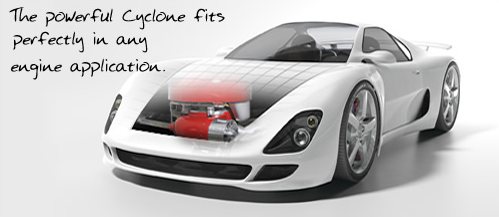
Simplified diagram of the Cyclone steam engine
Steam engines. For most of us, they conjure images of horseless buggies, paddle ships and classic locomotives, but soon they may be setting new speed records and hitting new benchmarks for efficiency--potentially in passenger cars.
Cyclone Power Technologies today announced it has completed and shipped a full scale model of the engine being built for the U.S. Land Steam Record Team. At 180 horsepower and peak torque of 850 pound-feet--at 1 rpm--the engine promises to deliver a steam-powered speed record with a marriage of old and new technology. Being the powertrain nerds we are, we took a closer look at the system.
Defined by Cyclone as a Rankine Cycle heat regenerative external combustion engine, the Cyclone Engine uses a six-piston radial layout to extract power from supercritical steam. Supercritical steam is water heated to 1,200 degrees Fahrenheit, existing in a phase state that's not really a liquid or a gas, but can behave like both. The supercritical steam is contained within a tubular coil system and then released into the cylinders, compressing the pistons and rotating the crank shaft through a unique spider bearing. Once the steam has done its job, it enters the cooling phase to return to its liquid state before heading back up to be superheated again. Water also serves as the lubricant for the system, eliminating the need for oil or oil changes.
Heat for the whole process is created in an atmospheric pressure combustion chamber, meaning almost any fuel can be used, without producing many of the harmful by-products of high-pressure internal combustion engines, such as oxides of nitrogen. Because the fuel circulates in the combustion chamber until it's all consumed, and much of heat generated is contained within the closed-loop system, Cyclone says their engine can convert up to 46 percent of the fuel energy into torque, a figure about 15 percent higher than the most efficient internal combustion engines, including diesels.

The Cyclone engine packaged in a passenger car format
It's an elegant way to extract power from fuel and deliver it to the ground, and it's a way Cyclone hopes to eventually push into the passenger car segment. Its ability to run on almost any fuel, high efficiency and low emissions mean it may well be even better suited to the task of propelling the cars of the 21st Century than rusty coal-fired boilers were to building the infrastructure of the 19th Century.
Check out the video below for a quick explanation of the engine tech from the man behind it, Harry Schoell. And when you're done, head over to the U.S. Land Steam Record Team's site to learn more about their attempt to break the 148-mph record.
